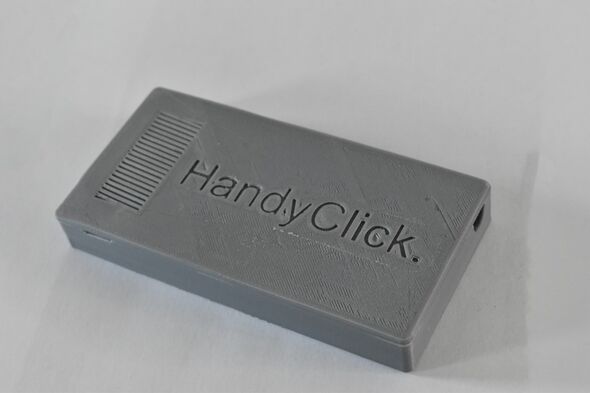Students develop prototype to keep senior citizens connected
Four students who this year took the new USE Learning Line (ULL) focusing on the Internet of Things have developed the ‘HandyClick’. This tool enables older people to communicate more easily with their mobile devices. The winning prototype caught the attention of investors and may lead to a startup.
During the first year of this new USE Learning Line the chosen theme was ‘ageing society’. Over a period of seven months forty students completed this Challenge Based Learning program, the most important phases of which are the design and the technical development.
“In these times of corona it is difficult to stay in touch with others, and if we have contact, it has to be online using a mobile device,” says Yip van Ginkel, second-year Computer Engineering and one of the students on the winning team. This past year everyone - young and old - has had to communicate online, but if you are getting on in years and are not keen on mobile devices it can be a bit of a struggle. Van Ginkel: “We devised a tool for this group that reduces the number of clicks needed to pull up an app, or pull up a particular functionality in an app. This makes it easier to operate a mobile device. Facetime - to name just one example - is brought a step closer and with it loneliness is pushed a step further away.”
Difficult testing
Corona proved not only a source of inspiration for the team members, however. The pandemic certainly put obstacles in the team's way. “Besides the fact that we have seen each other in person very little, it made testing difficult,” explains Van Ginkel. “We were keen to go into care homes and put a device into the hands of older people. Instead, we came up with another solution for this phase: we used our own parents as the test group.”
Even though the team members rarely saw each other, they managed to work together smoothly. “We each had our own tasks and given our various backgrounds the allocation was pretty automatic. As a student of Computer Engineering I did the programming work, while my teammate Christiaan Bloo, drawing on his background at Industrial Design, took on the design of the tool.” Still, unavoidably, the second-year student did miss the sociable fun that comes with being in the same room together. Together with Van Ginkel and Bloo, Atjen von Liebenstein and Stijn van de Werken, both students at Electrical Engineering, are also part of the winning team.
That the students have high ambitions for their ‘HandyClick’ is evident when Van Ginkel talks about the competitive assessment they have already carried out. “A number of products already exist that are similar to HandyClick. And so we don't want to reveal everything about the software, because the plan is to launch the product on the market in a year's time, with the help of an investor.” This has inspired the team to carry on improving the prototype in the coming months.
Read on below the photo.
Extremely proud
Course coordinator and associate professor at Electrical Engineering Oded Raz says he is extremely proud of the students. Raz: “Last year when we were preparing this new USE Learning Line we aimed to get ninety participating students, but eventually that number became forty. It has been a chaotic year, what with the outbreak of corona, and the fact that this is the first year we have offered this learning trajectory. So it is fantastic that a workable product has been produced so soon, first time around.”
Raz compares the prototype produced by Van Ginkel and his fellow students with the products delivered by the other nine teams. “The big difference between HandyClick and the other products is that right from the start this team was very methodical. Some groups found out only halfway through that the product they were developing already existed. Then they had to start all over again in a tearing hurry and that meant they had less time.”
Raz says that he too has learned a lot from this first year. “In that sense it was also a test to see whether it wasn't asking too much of second-year students, and whether we need to give them more guidance.” Next year this guidance will be available. Raz: “We won't be dropping the students in at the deep end and, if possible, we want to work more with clients and find out what the client needs. The marketing component fell by the wayside this time round due to corona.” For next year, Raz can already announce the theme for the products to be developed: ‘connected devices for health’.



Discussion